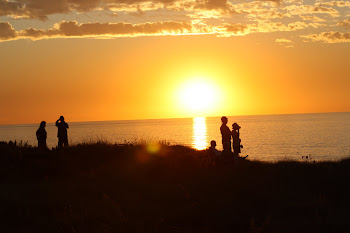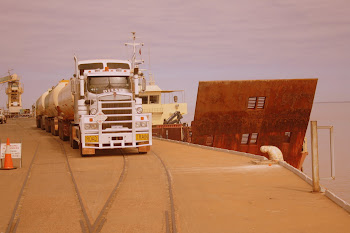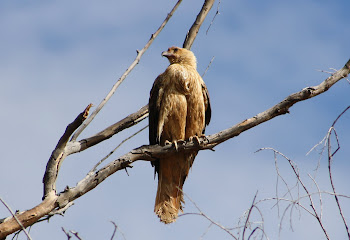It's time to hit the road again and get out and explore as much of Australia as possible
Coalseam National Park, Western Australia

Coalseam National Park, Western Australia
Followers
Thursday, 22 September 2011
Wildflower Season in Western Australia
Wildflower Season in Western Australia
Everybody has been telling us that this is the best wildflower season in WA since 1994, the principal reason being the widespread rains throughout winter. The wheat growing areas also seem to be having a huge year. Vast hectares of canola are also brightening up the countryside with huge swathes of bright yellow set off against the wheat and other crops.
We travelled from Geraldton to Mullewa in our first foray into wildflower country. The Mullewa Wildflower Festival was on in the town hall. The hall had been lavishly decorated with cut wildflowers including (incredibly) a couple of dug up wreath flowers. Even though the display was supposed to last for a week, the flowers were already beginning to look a little limp on the second day. The variety on display was excellent, with many native orchids I was seeing in the flesh for the first time. Were really impressed by the wreath flowers and decided to track down some specimens in the wild at the earliest opportunity.
That opportunity was to arise a couple of days later when we moved to Morowa, just a little further down the road. The really helpful and enthusiastic lady volunteer in the tourist information centre was armed with maps of reported sightings of wreath flowers and the location of the best wildflower displays including a variety of native orchids, so off we went.
The wreath flower (Lechenaultia macrantha) is not exactly rare, but is probably best described as uncommon. Its range is confined to a relatively small area from Shark Bay to Mullewa, Paynes Find and Murchison. The flowers like to grow in woodland areas particularly in disturbed soil, so they are often found after grading and clearing, on roadsides, along railway lines and especially in gravel pits.
We travelled about 40 Km out of town to a reported sighting and we were not disappointed. At this roadside location there were between 30 and 40 wreath flowers, nearly all in full bloom, some up to 40 cm across, an outstanding display.
The locals around Morawa are very proud of the fact that the wreath flowers grow in their area. I was driving slowly along the shoulder of the road looking for the flowers when I was passed by a local driving at speed. He disappeared around a bend and then turned around and came back and gave me the correct location that turned out to be just a bit further up the road – very friendly, helpful folk!
Having photographed the wreath flowers from just about every angle and stood and looked at them for quite a long time we reluctantly moved on to find Canna, a location with an outstanding display of many types of native orchids. I have seen pictures in my various orchid books of many of these specimens and here they were in abundance. I could write a blog on orchids alone. I will include just a small number in the pictures in this blog.
NEXT BLOG, MORE WILDFLOWERS
Monday, 12 September 2011
SHARK BAY / DENHAM TO GERALDTON
It was with mixed feelings that we left the warmth of Denham and the delights of Shark Bay, headed further south across the 28th parallel and officially left the north west of Western Australia.
It’s about a 400 Km run from there through to Geraldton so we decided to stop at a free camp at the Murchison River for the night. It was another pleasant afternoon chatting with some other travellers and swapping tales of good caravan parks (and the not so good!) and service station operators with reasonably priced fuel who were not intent on ripping travellers off.
There are quite a few stations / truckstops on the travellers’ “no go” or “use only as a last resort” list including once again the infamous Nanutarra Roadhouse on that very long stretch between Karratha and Carnarvon that we managed to avoid completely this time because we spent a couple of days at Onslow and filled up there at a reasonable price.
THE Nanutarra Roadhouse consistently charges far in excess of a reasonable price for fuel. We expect to pay a bit more because of the remote location and the fact that they have to run generators for power etc. etc. but Nanutarra always manages to charge very much over the expected.
We ran into quite a bit of wind on the run into Geraldton and the going was fairly tough heading directly into it. Then, to make matters much worse, I felt a fairly significant loss of power.
I diagnosed it as either the air mass regulator or a partially blocked fuel filter brought about by a load of dirty diesel (I have had some experience with air mass problems previously.) It was a struggle to maintain any sort of reasonable speed and I was pleased to make Geraldton with no further trouble, although the engine warning light came on a couple of times.
Thankfully, there is a Nissan dealer in Geraldton and they diagnosed the problem as a faulty air mass sensor. That was fine, although (of course) they didn’t have the requisite part, and it was Friday, so we were forced to stay a little longer than planned. It saved me a little time in one respect because I was able to get the 140,000 Km service done there instead of Perth as planned. Fortunately the dealer gave me a courtesy car for the five days so we were still able to explore the area.
Geraldton is quite a nice city and the surrounding areas were beginning to display some spectacular wildflowers. I think my next blog will be all wildflowers.
Geraldton has a strong connection with HMAS Sydney, the ship having visited there a number of times before its loss to the German raider Kormoran further up the coast nearer to Carnarvon.
The HMAS Sydney memorial at Geraldton is outstanding. Built of the finest materials, with excellence of design and containing sculpture and construction of an extremely high standard, the memorial is situated on a hill overlooking the city and looking out to sea.
The dome covering the sanctuary is made up of 645 seagulls, one for each member of the crew that lost his life in the sinking of the Sydney by the German raider Kormoran on the 19th of November 1941. The dome covers a podium constructed of a ship’s propeller that serves as a wreath laying altar.
An unforgettable feature is the statue ”the waiting woman” near a depiction of the prow of the Sydney. They are both very powerful images. The waiting woman is leaning into the wind, gazing anxiously towards the sea and the horizon. According to the sculptor’s explanation, the woman represents the all-encompassing “waiting woman” grieving for their menfolk. Once you see this memorial, you won’t forget it.
NEXT BLOG; INTO WILDFLOWER COUNTRY.
Monday, 5 September 2011
CARNARVON and SHARK BAY / DENHAM
The trip from
Giralia to Carnarvon was uneventful, but there were quite a few stops along the
way to have a look at the increasing numbers of wildflowers along the
roadsides. All the WA locals we speak to tell us that this should be a really
good year for wildflowers right across the state because of recent rains, so we
have that to look forward to.
One jarring note
occurred when we re-crossed the Tropic of Capricorn, this time heading
south. We were not all that happy about
the prospect of heading towards the cooler weather, but the time has come to
head towards Perth. Carnarvon was the first stop.
The Carnarvon area
produces a fairly large percentage of WA’s veggies and large farms dot the
landscape close to town. The supermarkets have a lot of fresh local stuff
including local bananas. I can’t understand why local bananas from just up the
street still cost over $13 a kilo, a price similar to that charged for Qld
bananas after the floods etc., sounds like a rip off to me and it’s hardly
surprising that no-one seems to be buying them!
Carnarvon is a
major centre for the fishing industry and it was nice to have a couple of nice
seafood lunches, makes a change from focaccias and ham, cheese and tomato
sandwiches.
There’s a few
things to see near Carnarvon. Naturally there’s a Saturday market albeit a
little small, but a market nonetheless. A drive out to the blowholes is a must
even though they’re about 60Km out of town. The blowholes are, as expected,
naturally formed passages in the rocks where the action of the waves forces
spouts of water to shoot up into the air…. fascinating.
As the sign at the
blowholes says “King Waves Kill and it’s easy to see how rock fishermen could easily
be dislodged by large waves. There were a couple of large waves while I was
looking around the area and I did manage to get a couple of pics of the splash
behind the Patrol… impressive.
Just along from The
Blowholes is a local memorial to HMAS Sydney, lost with all hands on 19th
November 1941 near there.
On that day HMAS
Sydney, a light cruiser had a fatal engagement with a German raider, the
auxiliary cruiser HSK Kormoran. There are various theories as to why the
captain of the Sydney allowed his ship to come so close before properly
identifying the Kormoran as a warship rather than a merchantman, it was to be a
fatal mistake (if that’s what happened).
In any event, the
Sydney was lost with all 645 crew perishing. Some German survivors were picked
up at Red Bluff, not far from the site of the memorial. Some debris from the
Sydney also washed ashore in this vicinity, but the location of the ship itself
was not discovered until very recently.
We spent a little
more time than planned in Carnarvon waiting for some mail to arrive, but once
we received that it was off to Denham for a couple of days of beach time.
Denham was again
fairly busy and we had to spend a couple of nights in an overflow area without
power or water before we could move into the caravan park itself. We really
have no problems doing that, we carry plenty of water, enough for a few short
showers if staying in the bush and the battery power is sufficient to run all
of our lighting and our inverter takes care of the TV / video player. During
the day our solar panels also allow use of a fan powered via the inverter if
the weather gets a bit hot and, of course we still have the generator to fall
back on if we need the aircon Iit’s a tough life!!
The Denham / Shark
Bay council has done very well with general signage and with the little things
that tourists like. Unfortunately you can’t legislate for good or even adequate
coffee and the general standard of coffee here was quite poor – more like hot weak
coffee flavoured milk L.
Once again I rued the day that I decided to leave my treasured De Longhi coffee machine at home.
The foreshore areas
are nicely grassed with plenty of seating and playgrounds for the kids and lots
of picnic areas and places to just sit and admire the view. For fishermen (or
fishers if you want to be politically correct) there is a state of the art fish
cleaning table in stainless steel with positions for about eight people,
running water and bins very near at hand. As a consequence, the table is always
clean and tidy for the next person.
We were at a bay
nearby to Denhan and I think we discovered why it is called Shark Bay, have a
look at the picture!!
About 20 Km out of
town is Eagle Bluff, a large, well constructed, elevated walkway allowing
viewing of some of the nearby seagrass meadows and patrolling sharks. The area
is also the home of quite a few dugong. The walkway provides a view of the bay
and in the far distance, a mountain of salt at the Dampier salt facility as
well as the promontory leading to Steep Point, the westernmost point in
Australia.
Many beaches on
Shark Bay are of shells instead of sand. There are uncountable billions of
small white shells. At the aptly named Shell Bay nearby the shells have been naturally
compressed and are able to be cut into blocks. In the past, buildings have been
made from such blocks, including one of the local churches.
Little Lagoon, a
4wd friendly picnic spot not far north of Denham is another place where the
beaches are of billions of shells rather than of sand. This area is a haven for
sea birds
Monkey Mia is about
25 Km north of Denham, famous for its visiting dolphins. We had been there once
before and were very underwhelmed by the experience. I believe that the whole
dolphin thing is very over managed by National Parks or CALM or whoever the
authority is. We didn’t go there this time.
Denham on Shark Bay
is a very pleasant and relaxing part of the world even though it’s about 130 Km
in from the main highway and, of course, the same distance back to the highway.
Next
stop, down across the 28th parallel to wildflower country.
Subscribe to:
Comments (Atom)
Posy Star Flower, near Perenjori WA

Posy Star Flower, near Perenjori WA
lemon scented sun orchids, near Perenjori Western australia

Wiry Honey Myrtle, Coorow Western Australia

The very strange Ant orchid, Canna Western Australia

Rosy cheeked donkey orchid, Canna Western Australia

Massed Cowslip Orchids, Canna Western Australia

Pink Pokers near Morowa Western Australia

Dunno whether yellow is really my colour!

View from Eagle Bluff near Denham WA

Black faced cuckoo shrike, Robe River WA

White-plumed honeyeaters, Robe River WA

Sturts Desert Pea grows on a beach!

Budgies, Robe River WA

RAAF graffiti from 1945, Old Onslow WA

Perhaps I could dye my hair, get an accent and get a job !!

Harding Dam near Roebourne WA, more rock piles

Free camp Peawah River West

Sundowners, Barn Hill Station WA

Road train Port Hedland, 84 wheels!

Wandjina, creators of the dreaming

Midnight at the oasis??? nah just Cable Beach at sunset

The elusive red tailed black cockatoo

Caroline Pool campsite on the Duncan Highway WA

Tawny Frogmouth, Derby

China Wall, just outside Halls Creek

China Wall, just outside Halls Creek
Iron ore roadtrain, main street, Wyndham

Magpie Goose, Marglu Billabong near Wyndham

Radjah Shellducks Parry Lagoon WA

Whistling Kite, Parry Lagoons near Wyndham

Victoria River NT Barra Spot

Victoria River NT Barra Spot
Victoria River NT Barra Spot

Victoria River NT Barra Spot
Freshwater croc, about 5 feet Mataranka

Freshwater croc, about 5 feet Mataranka
A well decorated bar Daly Waters NT

1942 Furphy is this the original tank??

Back road shortcut near Tennant Creek

Spectating kite

The new (to us) grevillia

Crocs near Mataranka Springs

Crocs near Mataranka Springs
Lake Mary Ann, Tennant Creek

Cultural Centre

Chilli at the Daly Waters pub

Bras at the bar

Star Flowers

The Ghan Part 1

The Ghan Part 2

The Ghan Part 2
More Flying Foxes

More Flying Foxes
The Stuart River near Avon Downs

Grave of Aeneas Gunn, Elsey Station

Fill 'er up...more than 100,000 litres

Members of the mysterious Sundowners cult

Rainbow Bee Eater, Parry Lagoon WA

Rainbow Bee Eater, Parry Lagoon WA
Grey Shrike Thrush Parry Lagoon near Wyndham

Old Halls Creek Road near Wyndham

Australian pratincole near Marglu Billabong, near Wyndham

Cockburn Range, Gibb River Road near El Questro

Mystery Object, What is it Brinky?

Ord Dam WA

Mindil Markets

Mindil Night Markets
More of Isa

More of Isa
Beef on the move

Beef on the move
Darwin's getting closer!!

Tribute to Aboriginal Stockmen

Sundowners

Sundowners, Mindil Beach
More stuff for the mines

Maestro discovers camels, hey Rob, what's that??

Whistling Kite near Halls Creek

Ord River barra fishing spot off Parry Creek Road WA

The elusive brolgas, Marglu Billabong near Wyndham

We Love Boabs

Square dancers

Square dancers add some colour , Mindil Markets Darwin he didn't look that happy!!!
In the scrub near Winton

Snake Creek WW2 "shelter" Adelaide River
